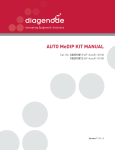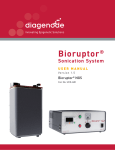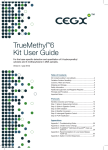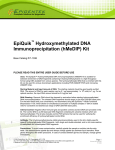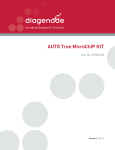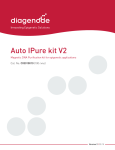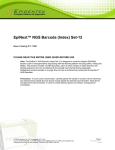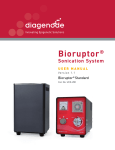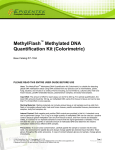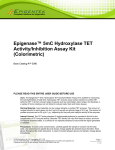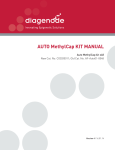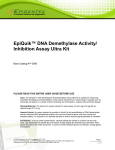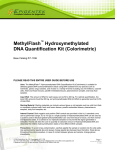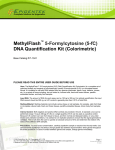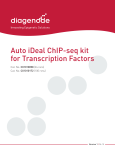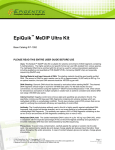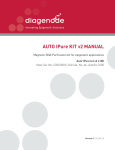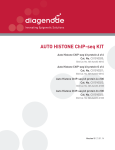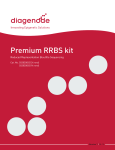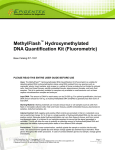Download - Diagenode
Transcript
AUTO hMeDIP KIT MANUAL Hydroxymethylated DNA Immunoprecipitation Auto hMeDIP kit x16 (monoclonal rat antibody) Cat. No. C02010033 (Old: AF-Auto02-0016) Auto hMeDIP kit x16 (monoclonal mouse antibody) Cat. No. C02010034 Auto hMeDIP kit x16 (polyclonal rabbit antibody) Cat. No. C02010035 FEATURES • Get your hydroxymethylation profile in 24h • Includes hydroxymethylated, methylated and unmethylated DNA for QC • Improved reproducibility using the IP-Star® • Highly specific (monoclonal antibody for 5hmc) • Optimized DNA isolation buffer Version 5 I 03.02.14 Technical Assistance & Ordering Information Diagenode s.a. BELGIUM | EUROPE Diagenode Inc. USA | NORTH AMERICA LIEGE SCIENCE PARK 400 Morris Avenue, Suite #101 Rue Bois Saint-Jean, 3 Denville, NJ 07834 - USA 4102 Seraing - Belgium Tel: +1 862 209-4680 Tel: +32 4 364 20 50 Fax: +1 862 209-4681 Fax: +32 4 364 20 51 [email protected] [email protected] [email protected] [email protected] For a complete listing of Diagenode’s international distributors, visit: http://www.diagenode.com/en/company/distributors.php For the rest of the world, please contact Diagenode s.a. Technical Assistance At DIAGENODE we pride ourselves on the quality and availability of our technical support. Our Technical Services Departments are staffed by experienced scientists with extensive practical and theoretical expertise in molecular biology and the use of DIAGENODE products. If you have any questions, or experience any difficulties regarding the SX-8G IPStar or DIAGENODE products in general, do not hesitate to contact us. DIAGENODE customers are a major source of information regarding advanced or specialized uses of our products. This information is helpful to other scientists as well as to the researchers at DIAGENODE. We therefore encourage you to contact us if you have any suggestions about product performance or new applications and techniques. For technical assistance and more information call the DIAGENODE Technical Service Department or contact your local distributor. PAGE 3 Contents Introduction. . . . . . . . . . . . . . . . . . . . . . . . . . . . . . . . . . . . . . . . . . . . . . . . . . . . . . . . . . . . . . . . . . . . . . . . . . . . . . . . . 4 SX-8G IP-Star Automated System for ChIP, MeDIP &MBD. . . . . . . . . . . . . . . . . . . . . . . . . . . . . . . . . . . . . . . . . . 5 Kit Method Overview . . . . . . . . . . . . . . . . . . . . . . . . . . . . . . . . . . . . . . . . . . . . . . . . . . . . . . . . . . . . . . . . . . . . . . . . . 8 Kit Materials. . . . . . . . . . . . . . . . . . . . . . . . . . . . . . . . . . . . . . . . . . . . . . . . . . . . . . . . . . . . . . . . . . . . . . . . . . . . . . . . 9 Kit Content. . . . . . . . . . . . . . . . . . . . . . . . . . . . . . . . . . . . . . . . . . . . . . . . . . . . . . . . . . . . . . . . . . . . . . . . . . . . . . 9 How to perform Automated IPure in the SX-8G IP-Star ® Compact. . . . . . . . . . . . . . . . . . . . . . . . . . . . . . . . . . 11 Running a protocol. . . . . . . . . . . . . . . . . . . . . . . . . . . . . . . . . . . . . . . . . . . . . . . . . . . . . . . . . . . . . . . . . . . . . . . 12 How to perform Automated hMeDIP in the SX-8G IP-Star ®. . . . . . . . . . . . . . . . . . . . . . . . . . . . . . . . . . . . . . . . 18 Loading and running protocol. . . . . . . . . . . . . . . . . . . . . . . . . . . . . . . . . . . . . . . . . . . . . . . . . . . . . . . . . . . . . . 19 Shutting down the SX-8G IP-Star®. . . . . . . . . . . . . . . . . . . . . . . . . . . . . . . . . . . . . . . . . . . . . . . . . . . . . . . . . . 22 Quantitative PCR & Data Analysis . . . . . . . . . . . . . . . . . . . . . . . . . . . . . . . . . . . . . . . . . . . . . . . . . . . . . . . . . . . . . 23 Results. . . . . . . . . . . . . . . . . . . . . . . . . . . . . . . . . . . . . . . . . . . . . . . . . . . . . . . . . . . . . . . . . . . . . . . . . . . . . . . . . . . . 24 Troubleshooting Guide. . . . . . . . . . . . . . . . . . . . . . . . . . . . . . . . . . . . . . . . . . . . . . . . . . . . . . . . . . . . . . . . . . . . . . . 24 Ordering Information. . . . . . . . . . . . . . . . . . . . . . . . . . . . . . . . . . . . . . . . . . . . . . . . . . . . . . . . . . . . . . . . Back Cover www.diagenode.com | PAGE 4 DIAGENODE AUTO hMeDIP KIT USER MANUAL Introduction The Novel Diagenode Auto hMeDIP kit is designed to immunoprecipitate hydroxymethylated DNA (hMethyl DNA IP). This kit is the first and only example of MeDIP kit specifically designed and fully validated for affinity-capture and detection of hydroxymethylated regions using the Diagenode highly specific antibody against 5-hmc. One of the fastest growing fields in biology and cancer research is epigenetics. While the underlying genetic code defines which proteins and gene products are synthesized, it is epigenetic control that defines when and where they are expressed. Epigenetic control is generally mediated by methylation of cytosine to 5-methylC (5-mC) in CpG islands and post-translational modification of histones. Methylation of CpGs near promoters is associated with gene silencing, as is deacetylation of histones. There is substantial interest and speculation in the role of a recently discovered second type of DNA methylation, 5-hydroxymethylcytosine (5-hmC), although its precise function has not yet been elucidated. This new cytosine base modification results from the enzymatic conversion of 5-Methylcytosine into 5-Hydroxymethylcytosine by the TET family of oxygenases. Preliminary results indicate that 5-hmC may have important roles distinct from 5-mC. Although its precise role has still to be shown, early evidence suggests a few putative mechanisms that could have big implications in epigenetics: 5-hydroxymethylcytosine may well represent a new pathway to demethylate DNA involving a repair mechanism converting hmC to C and, as such open up entirely new perspectives in epigenetic studies. Due to the structural similarity between 5-mC and 5-hmC, these bases are experimentally almost indistinguishable. Recent articles demonstrated that the most common approaches (eg. enzymatic approaches, bisulfite sequencing) do not account for 5-hmC. The development of the affinity-based technologies appears to be the most powerful and so far the only way to differentially and specifically enrich 5mC and 5hmC sequences. Recently, Diagenode launched new highly-specific monoclonal antibodies and kits for the differential study of the functions of 5-hmC and 5-mC. In the Auto hMeDIP kit, our antibody directed against 5-hydroxymethylcytosine is provided as well as hmeDNA, meDNA and unDNA internal IP PCR controls. The IP has been optimized to specifically select and precipitate hydroxymethylated DNA fragments by the use of our antibody, buffers and protocol. The IP efficiency can indeed be doublechecked with the use of our internal controls. The Auto hMeDIP kits allow you to perform DNA hydroxymethylation analysis of your sample together with optimized internal IP control. Performing hydroxymethylation profiling with the Auto hMeDIP kit is FAST, RELIABLE and HIGHLY SPECIFIC. In the Auto hMeDIP kit, the protocol has been improved to allow researchers to work in small tubes. The kit ensures the use of low amount of reagents per reaction. The number of steps is reduced and handling is easier with our Magnetic hMethyl DNA IP procedure. The hMeDIP protocol is flexible, as the IP’d DNA can be isolated and/or purified in different ways based on the downstream application: an extra-fast and simplified protocol is included in the Auto hMeDIP kit (for qPCR analysis); but more traditional methods are also proposed (see separate module). Moreover,our Magnetic Rack together with our new hMeDIP kit protocol ensures the best IP conditions by working at a constantly cooler temperature. The Diagenode Magnetic Rack has been designed to be used in IP experiments, keeping samples cool longer and allowing the use of small tubes to reduce the reaction volumes and waste of reagents. The hMeDIP kit protocol has been validated with our Bioruptor®. Nevertheless, DNA can be sheared with any in house protocol and sonication apparatus as long as efficiency is checked before use. The Auto hMeDIP kit contains all reagents you need for you hMeDIP Assay but it can be purchased with two additional modules for: 1/ Preparation of larger quantities of genomic DNA and 2/ “Traditional” purification of the IP’d DNA for subsequent next generation sequencing analysis. 1. The XL GenDNA Module is optimized for the preparation of large quantities of DNA ready-to-use in MeDIP. An optimized protocol for DNA shearing is provided as well. 2. The DNA purification includes all the reagents and buffers needed: eluting DNA from the washed beads after IP (using buffers D, E, F) and to proceed to phenol/chloroform extractions and ethanol precipitation (using DNAIP TE, DNA-IP co-precipitant and DNA-IP precipitant). Note that purification columns can also be used after elution. Innovating Epigenetic Solutions PAGE 5 SX-8G IP-Star® and SX-8G IP-Star® Compact Systems for automation of epigenetic applications Diagenode has developed two automated platforms (SX-8G IP-Star® and SX-8G IP-Star® Compact) designed to increase your lab’s productivity, efficiency and experimental reproducibility. The two automated platforms are capable of processing up to 16 samples per cycle. The automated systems processes sheared chromatin (or DNA) to deliver purified DNA ready for qPCR, amplification, microarray and sequencing analysis. Both, the SX-8G IP-Star® and SX-8G IP-star® Compact have an easy-to-use open software that provides you with flexibility. This allows you to create your personal protocol according to your specific needs. Major benefits of Diagenode Automated Platforms SX-8G IP-Star® Compact SX-8G IP-Star® > High resolution ChIP-seq and MeDIP-seq profiles > Automated library preparation for Next Generation sequencing > Reduces hands on time to just 30 minutes > Reduces variability between operators and labs > Ideal for low sample starting amounts > Compatible with Diagenode Kits (Auto ChIP kit, Auto Histone ChIP-seq kit, Auto Transcription ChIP-seq kit, Auto True MicroChIP kit, Auto MeDIP kit, Auto MethylCap kit, Auto hMeDIP, Auto IPure kit) > Reduces cross-contamination www.diagenode.com | PAGE 6 DIAGENODE AUTO hMeDIP KIT USER MANUAL SX-8G IP-Star® Compact SX-8G IP-Star® ChIP-seq, MeDIP-seq, MethylCap-seq, hMeDIP, IPure, Sample preparation, Re-ChIP, MagBisulfite, RNA-IP, Library preparation for NGS platforms. ChIP-seq, MeDIP-seq, MethylCap-seq, hMeDIP, IPure, Sample preparation, Re-ChIP, MagBisulfite, RNA-IP. User interface Intuitive touch screen panel PC Software User friendly Software training not required Software training before use Dispensing Automated dispension of assay reagents Manual dispension of assay reagents Protocol optimization (flexible parameters) Antibody coating (temperature, time, mixing speed) Immunoprecipitation (temperature, time, mixing speed) Washes (temperature, time, mixing speed) Antibody coating (temperature, time) Immunoprecipitation (temperature, time) New protocol development Achievable by Diagenode product specialist Achievable by customer after training Characteristics 750W x 740 D x 610 H | 100 kg 8 Nozzles X-Y-Z axis | 4 – 95°C 1070W x 650 D x 780 H | 130 kg 8 Nozzles X-Y-Z axis | 4-95°C Applications Software Innovating Epigenetic Solutions PAGE 7 Improved reproducibility Our SX-8G IP-Star will increase the immunoprecipitation reproducibility between IPs performed by the same as well as by different operators (see figure 1 and 2 below). Reagents (Antibodies, buffers,...) and sheared chromatin were identical for “ManChIP” and “AutoChIP”. The SX-8G IP-Star Automated system removes variation that can be created by manual handling and allows you to optimize and standardize your assay within a lab. The SX-8G IP-Star is designed to improve the accuracy and the reproducibility of any immunoprecipitiation experiment. Man ChIP SD(IgG)=0,69% SD(H3K9me3)=23,84% Man ChIP SD(IgG)=0,69% SD(H3K9me3)=23,84% SD(IgG)=1,4% SD(H3K9me3)=2,38% C % of input % of input 100,0 80,0 60,0 100,0 40,0 80,0 20,0 60,0 SD(IgG)=0,94% SD(H3K9me3)=11,36% SD(IgG)=0,17% SD(H3K9me3)=1,12% B A ChIP 1 ChIP 1 ChIP 2 SD(IgG)=0,94% SD(H3K9me3)=11,36% 50,70 ChIP 1 ChIP 2 SD(IgG)=1,4% 98,62 95,26 SD(H3K9me3)=2,38% ChIP 2 34,63 ChIP 1 ChIP 2 98,62 B 1,96 ChIP 1 D C SD(IgG)=0,17% SD(H3K9me3)=1,12% 57,83 56,25 95,26 A ChIP 1 SD(IgG)=0,09% SD(H3K9me3)=0,65% ChIP 1 ChIP 2 SD(IgG)=0,09% SD(H3K9me3)=0,65% 44,75 43,83 D ChIP 2 ChIP 2 57,83 56,25 ChIP 1 0,63 50,70 1,86 1,62 2,06 1,42 1,54 0,63 1,86 1,62 2,06 1,42 1,54 ChIP 2 1,42 44,75 43,83 34,63 40,0 Figure 1: Manual ChIP. Four different operators have each performed two ChIP experiments using H3K9me3 antibody on the genomic region SAT2 (positive locus). 10,000 Hela cells have been used per IP. Reagents and sheared chromatin were identical per assay. The standard deviations between the ChIPs performed by the same operator and between the four different operators are displayed. 20,0 1,96 1,42 Auto ChIP SD(IgG)=0,28% SD(H3K9me3)=1,6% Auto ChIP SD(IgG)=0,28% SD(H3K9me3)=1,6% 100,0 90,0 % of input % of input 80,0 ChIP 2 ChIP 1 70,0 100,0 ChIP 3 54,71 56,25 60,0 90,0 ChIP 4 57,83 54,34 50,0 80,0 40,0 70,0 ChIP 2 ChIP 1 ChIP 3 54,71 56,25 30,0 60,0 ChIP 4 57,83 54,34 20,0 50,0 10,0 40,0 30,0 1,00 1,26 IgG H3K9me3 IgG 1,45 H3K9me3 IgG Figure 2: Automated ChIP. Four ChIP experiments using H3K9me3 antibody on the genomic region SAT2 (positive locus) have been performed by the SX8G IP-Star. 10,000 Hela cells have been used per IP. Reagents and sheared chromatin were identical per assay. The standard deviations between the four ChIPs performed by the SX-8G IP-Star are displayed. 0,81 H3K9me3 IgG H3K9me3 20,0 10,0 1,00 1,26 IgG H3K9me3 IgG 1,45 H3K9me3 IgG 0,81 H3K9me3 IgG H3K9me3 www.diagenode.com | PAGE 8 DIAGENODE AUTO hMeDIP KIT USER MANUAL Kit Method Overview Chromatin/DNA Shearing Chromatin/DNA Preparation (Bioruptor® Sonication) Increased Reproducibility Chromatin Shearing Optimization kit (Low SDS, Medium SDS and High SDS) STEP 1 Automated & High -Throughput No “Foaming” ST E No Risk of Contamination P 2 Next Gen Sequencing Bioruptor® Pico Auto MethylCap Kit nds-on time 10 min 15 STEP 4 DNA Purification IPure kit (magnetic purification) DNA Isolation Buffer S mi n P TE 6 EP 5m Ha ST 3 Auto hMeDIP Kit in Auto MeDIP Kit m DNA Methylation EP Auto Transcription ChIP kit ST Auto True MicroChIP Kit Auto Histone ChIP-Seq kit 20 Chromatin study in Magnetic IP Size Selection with AMPure® XP beads 5 Library Preparation Illumina® TruSeq™ ChIP NEBNext® ChIP-seq MicroPlex Library Preparation kit (50 pg, multiplex, manual) qPCR Figure 3. Diagenode provides a full suite of automated solutions for ChIP experiments. For Step 1, we offer products to isolate nuclei and chromatin. Step 2 describes reproducible sample shearing with the Bioruptor® product line. In Step 3 and Step 4, the Diagenode IP-Star Compact provides error-free, walk-away automation for all your immunoprecipitation and antibody capture needs. Innovating Epigenetic Solutions PAGE 9 Kit Materials Kit Content Auto hMeDIP kit x16 (monoclonal rat antibody) Cat. No. C02010033 (Old: AF-Auto02-0016) Component Quantity Storage Water EF-113-0008 - 24 ml 4°C hMeDIP buffer H1 EF-114-0001 Ion chelator mix included (10x). 3 ml 4°C hmeDNA control EF-115-0040 PCR product (0,02 ng/µl). 40 µl -20°C meDNA control EF-116-0040 PCR product (0,02 ng/µl). 40 µl -20°C unDNA control EF-117-0040 PCR product (0,02 ng/µl). 40 µl -20°C 5-hmC monoclonal antibody (rat) EF-118-0032 1,6 µg/µl 32 µl (50 µg) -20°C Rat IgG EF-119-0050 1 µg/µl 50 µl -20°C/4°C EF-120-0220 The beads are supplied for 16 IPs; detergent and 0.02%, sodium azide included. 220 µl 4°C Do not freeze EF-121-0004 BSA and Ion chelator mix included. 12 ml 4°C hMeDIP buffer H3 EF-122-0002 Ion chelator mix included. 4 ml 4°C DNA isolation Buffer (DIB) EF-123-0004 - 5 ml 4°C Proteinase K EF-124-0040 100 x stock solution. 40 µl - 20°C hmeDNA primer pairs EF-125-0050 5 μM each (Rv & Fw). 50 µl - 20°C meDNA primer pairs EF-126-0050 5 μM each (Rv & Fw). 50 µl -20°C unDNA primer pairs EF-127-0050 5 μM each (Rv & Fw). 50 µl -20°C Mouse Sfi1 primer pairs EF-128-0050 5 μM each (Rv & Fw). 50 µl -20°C Quantity Storage Protein G-coated magnetic beads hMeDIP buffer H2 Cat. No. Comments Auto hMeDIP kit x16 (monoclonal mouse antibody) Cat. No. C02010034 Component Cat. No. Comments Water EF-113-0008 - 24 ml 4°C hMeDIP buffer H1 EF-114-0001 Ion chelator mix included (10x). 3 ml 4°C hmeDNA control EF-115-0040 PCR product (0,02 ng/µl). 40 µl -20°C meDNA control EF-116-0040 PCR product (0,02 ng/µl). 40 µl -20°C unDNA control EF-117-0040 PCR product (0,02 ng/µl). 40 µl -20°C 5-hmC monoclonal antibody (mouse) EF-131-0050 1 μg/μl 50 μl (50 μg) -20°C Mouse IgG EF-119-0050 1 µg/µl 50 µl -20°C/4°C EF-133-0220 The beads are supplied for 16 IPs; detergent and 0.02%, sodium azide included. 220 µl 4°C Do not freeze EF-121-0004 BSA and Ion chelator mix included. 12 ml 4°C hMeDIP buffer H3 EF-122-0002 Ion chelator mix included. 4 ml 4°C DNA isolation Buffer (DIB) EF-123-0004 - 5 ml 4°C Proteinase K EF-124-0040 100 x stock solution. 40 µl - 20°C hmeDNA primer pairs EF-125-0050 5 μM each (Rv & Fw). 50 µl - 20°C meDNA primer pairs EF-126-0050 5 μM each (Rv & Fw). 50 µl -20°C unDNA primer pairs EF-127-0050 5 μM each (Rv & Fw). 50 µl -20°C Mouse Sfi1 primer pairs EF-128-0050 5 μM each (Rv & Fw). 50 µl -20°C Anti-mouse IgG-coated magnetic beads hMeDIP buffer H2 www.diagenode.com | PAGE 10 DIAGENODE AUTO hMeDIP KIT USER MANUAL Auto hMeDIP kit x16 (polyclonal rabbit antibody) Cat. No. C02010035 Component Cat. No. Comments Quantity Storage Water EF-113-0008 - 24 ml 4°C hMeDIP buffer H1 EF-114-0001 Ion chelator mix included (10x). 3 ml 4°C hmeDNA control EF-115-0040 PCR product (0,02 ng/µl). 40 µl -20°C meDNA control EF-116-0040 PCR product (0,02 ng/µl). 40 µl -20°C unDNA control EF-117-0040 PCR product (0,02 ng/µl). 40 µl -20°C 5-hmC polyclonal antibody (rabbit) EF-134-0050 crude serum 50 μl -20°C Rabbit IgG EF-119-0050 1 µg/µl 50 µl -20°C/4°C EF-136-0220 The beads are supplied for 16 IPs; detergent and 0.02%, sodium azide included. 220 µl 4°C Do not freeze EF-121-0004 BSA and Ion chelator mix included. 12 ml 4°C hMeDIP buffer H3 EF-122-0002 Ion chelator mix included. 4 ml 4°C DNA isolation Buffer (DIB) EF-123-0004 - 5 ml 4°C Proteinase K EF-124-0040 100 x stock solution. 40 µl - 20°C hmeDNA primer pairs EF-125-0050 5 μM each (Rv & Fw). 50 µl - 20°C meDNA primer pairs EF-126-0050 5 μM each (Rv & Fw). 50 µl -20°C unDNA primer pairs EF-127-0050 5 μM each (Rv & Fw). 50 µl -20°C Mouse Sfi1 primer pairs EF-128-0050 5 μM each (Rv & Fw). 50 µl -20°C Protein A-coated magnetic beads hMeDIP buffer H2 Components available separately Description Reference Quantity Storage 96 well microplates WA-003-0010 10 RT Tips (bulk) WC-001-1000 1000 RT 200 µl tube strips (12 tubes/strip) + cap strips WA-001-0080 80 RT 200 µl tube strips (8 tubes/strip) + cap strips for SX-8G IP-Star® Compact WA-002-0120 120 RT Tips (box) WA-002-960 10 x 96 RT Kits and Modules available separately Description Reference Quantity Chromatin shearing optimization kit - Low SDS AA-001-0100 1 kit Chromatin shearing optimization kit - Medium SDS AA-002-0100 1 kit Chromatin shearing optimization kit - High SDS AA-003-0100 1 kit Reference Quantity IPure Description IPure Auto IPure 96 well microplates Innovating Epigenetic Solutions AL-100-0100 100 rxns AL-Auto01-0100 100 rxns WA-003-0010 10 pc SX-8G IP-STAR COMPACT ® How to perform Automated ChIP in the SX-8G IP-Star® Compact PAGE 12 DIAGENODE AUTO hMeDIP KIT USER MANUAL How to perform Automated hMeDIP in the SX-8G IP-Star® Compact Prior to hydroxyMethylated DNA immunoprecipitation (hydroxyMethyl DNA IP), DNA samples are first prepared and sheared with Diagenode GenDNA module (Cat. No. C03030020 (mc-magme-003)). Prepare reagents 1. Prepare the IP incubation mix w/o antibodies and w/o magnetic beads for all your hMeDIP reactions (Table 1). Table 1: IP incubation mix with no antibodies and no beads Reagent Volume per IP + INPUT Water 91.5 µl Volume per additional IP 76.25 µl hMeDIP buffer H1 12 µl 10 µl hmeDNA control 1.5 µl 1.25 µl meDNA control 1.5 µl 1.25 µl unDNA control 1.5 µl 1.25 µl DNA sample (0.1 µg/µl) 12 µl 10 µl 120.00 µl 100.00 µl TOTAL VOLUME NOTE: hMeDIP Buffer H1 contains detergent; if the appearance is cloudy and crystallized please warm gently prior to use. • Incubate at 95ºC for 10 minutes. • Quickly chill sample on ice (it is best to use ice-water). • Perform a pulse spin to consolidate your sample. • First, take out 10 μl per INPUT (that is 10% input) and transfer to a new labelled tube. • Keep the input samples at 4°C. The input sample is to be used as a control of starting material and it is therefore not to be used in IP. • 100 μl of the IP incubation mix will be used per IP 2.Prepare hMeDIP H1 (1:10) by diluting hMeDIP H1 buffer in water. 300 µl hMeDIP H1 (1:10) buffer are needed per IP reaction Innovating Epigenetic Solutions PAGE 13 Running a protocol Diagenode Splash Screen – A0 After the software start-up screen disappears, the Diagenode splash screen is displayed for several seconds, and then disappears. Start Screen – Top menu After the Digenode splash screen disappears, the start screen is displayed. This is the first active window; it allows the user to enter into three different parts of the software. USER ACTIONS: Buttons: • P rotocols • Maintenance (for technical services) • Information (for Diagenode contact details) Protocols screen All available protocols are displayed on this screen. Screen – [Categories Name] Protocol List After the user presses the “[Categories Name]” button, the “[Categories Name]” appears. When selected the protocol on the protocol list, the “Run” button shall turn executable. Buttons: • T he user presses the “Back” button. The user returns to the “Protocols” screen. • T he user presses the “Shutdown” button. The screen shall be changed to “Power Off”. • T he user presses the “Run” button. The screen shall be changed to “Sample number”. • Page up the list box. • Page down the list box www.diagenode.com | PAGE 14 DIAGENODE AUTO hMeDIP KIT USER MANUAL Screen – Sample number After the user presses the “Run” button, the “Sample number” appears. Buttons: • T he user presses the “Sample number” Text box. The screen will be changed to keyboard. • T he user presses the “Back” button. The user returns to the “Protocol List” screen. • T he user presses the “Next” button. The screen shall be changed to “Configuration” or “Layout information”. Keyboard Screen – Configuration After the user presses the next button from the “Sample number” screen, the “Configuration” screen appears. Buttons: • T he user presses the “Back” button. The user returns to the “Protocol List” screen. • T he user presses the “Next” button. The screen shall be changed to “Layout information”. • T he user presses the “Save Parameter” button. The screen will be changed to “Save Parameter - Confirmation”. - OK – Current parameters shown in the Display View will be stored to the [Protocol].ptd. And, returns the user to the display of the “Configuration” screen. - No – Returns the user to the display of the “Configuration” screen. • T he user presses the Text box. The screen will be changed to Keyboard or Speed list menu. Keyboard Speed list menu Block-PCR Tube Innovating Epigenetic Solutions PAGE 15 Screen – Layout Information After the user presses the “next” button from “Sample number” screen or “Configuration” screen, the “Layout Information” screen appears. Buttons: Layout information • T he user presses the “Back” button. The user returns to the previous screen. • T he user presses the “Next” button. The screen changes to “Set confirmation”. • W hen the user presses a block, that block is magnifies on the work surface layout background. The magnified view provides a better display of the correct method setup for that block on the work surface. • B ased on the selected protocol, the user follows the indications provided in the screens to set up correctly the different reagents and samples based on the selected ChIP protocol. Block-Tip Block-Regent Tip Rack Screen – Layout Information If the kit contains: • A rat monoclonal 5-hmC antibody, add 1.6 µl of the 5-hmC antibody or 2.5 µl of Rat IgG per tube. • A mouse monoclonal 5-hmC antibody, add 2.5 µl of the 5-hmC antibody or 2.5 µl of Rat IgG per tube. Block-PCR Tube • A rabbit polyclonal 5-hmC antibody, add 2.5 µl of the 5-hmC antibody or 2.5 µl of Rabbit IgG per tube. www.diagenode.com | PAGE 16 DIAGENODE AUTO hMeDIP KIT USER MANUAL Select a Protocol name Input value in the “Sample Number” Input value in the “Configuration” Current Temperature Value Screen – Set confirmation After the user presses the “next” button in the “Layout information” screen, the “Set confirmation” screen appears. At this point, user is expected to be ready to press RUN. Buttons: • The user presses the “Back” button. The user returns to the layout information screen. • T he user presses the “Run” button. This is the expected action when user gets to this display after reviewing blocks. Runs the protocol. Protocol name Progress Bar Remaining time Current Temperature Value Screen – Running After the user presses the “Run” button in the “Set confirmation” screen, the “Running” screen appears. Buttons: • The user presses the “Stop” button. The screen changes to “Stop Dialog”. Status screen is preferred as a progress bar that moves across the screen as the step progresses Innovating Epigenetic Solutions PAGE 17 Screen – Running status This screen gives informations about the current running step of the protocol. The user can check through this screen the passed and remaining time of the experiment. Screen – CAUTION INPUT is defined as INPUT= 10 μl Incubation Mix + 90μl DIB buffer IMPORTANT: Please note that the enriched methylated DNA in DIB buffer is single strand DNA that can be directly analyzed by qPCR. For downstream applications such as sequencing or arrays, the enriched methyated DNA needs to be purified by phenol/chroloform extraction and converted to double stranded DNA. Screen – Finish/End When the protocol is complete, a window appears telling user the run is over. The screen behind this window should be the Startup screen. When OK is pressed, then the Startup screen appears and the user can immediately begin to remove their sample and prepare the next run. At this point, user is expected to be ready to press RUN. Buttons: • T he user presses the “OK” button. Then screen shall be changed to “[Categories Name] Protocol List”. www.diagenode.com | PAGE 18 DIAGENODE AUTO hMeDIP KIT USER MANUAL Screen – Caution ! When the protocol finishes the user can return to the protocol list (screen A.) or warm the peltier block (screen B.) to eliminate possible condensation in the block. A. Innovating Epigenetic Solutions B. How to perform Automated ChIP in the SX-8G IP-Star® www.diagenode.com | SX-8G IP-STAR ® PAGE 19 PAGE 20 DIAGENODE AUTO hMeDIP KIT USER MANUAL How to perform Automated hMeDIP in the SX-8G IP-Star® Prior to hydroxyMethylated DNA immunoprecipitation (hydroxyMethyl DNA IP), DNA samples are first prepared and sheared with Diagenode GenDNA module (Cat# mc-magme-03). A) Prepare reagents 1. Prepare the IP incubation mix w/o antibodies and w/o magnetic beads for all your hMeDIP reactions (Table 1). Table 1: IP incubation mix with no antibodies and no beads Reagent Volume per IP + INPUT Water Volume per additional IP 91.5 µl 76.25 µl hMeDIP buffer H1 12 µl 10 µl hmeDNA control 1.5 µl 1.25 µl meDNA control 1.5 µl 1.25 µl unDNA control 1.5 µl 1.25 µl DNA sample (0.1 µg/µl) TOTAL VOLUME 12 µl 10 µl 120.00 µl 100.00 µl NOTE: hMeDIP Buffer H1 contains detergent; if the appearance is cloudy and crystallized please warm gently prior to use. • Incubate at 95ºC for 10 minutes. • Quickly chill sample on ice (it is best to use ice-water). • Perform a pulse spin to consolidate your sample. • First, take out 10 μl per INPUT (that is 10% input) and transfer to a new labelled tube. • Keep the input samples at 4°C. The input sample is to be used as a control of starting material and it is therefore not to be used in IP. • 100 μl of the IP incubation mix will be used per IP 2.Prepare hMeDIP H1 (1:10) by diluting hMeDIP H1 buffer in water. 300 µl hMeDIP H1 (1:10) buffer are needed per IP reaction B) Dispense prepared reagents into corresponding tubes (see picture below) Loading reagents: make sure that all reagents are in the bottom of the tubes (especially magnetic beads) before starting the protocol. DIB DNA isolation buffer (Input) Bead washes Washes hMeDIP 1 Innovating Epigenetic Solutions 2 3 4 5 6 7 8 9 DNA isolation buffer (IP) 10 11 12 PAGE 21 DIB Tube # Description Volume 1 DNA isolation buffer 2 Empty 90 µl 3 Magnetic beads 10 µl 4 hMeDIP H2 190 µl 5 IP Incubation Mix + Antibody * 100 µl 6 hMeDIP H1 (1:10) 100 µl 7 hMeDIP H1 (1:10) 100 µl 8 hMeDIP H1 (1:10) 100 µl 9 hMeDIP H3 100 µl 10 DNA isolation Buffer 100 µl 11 empty / 12 empty / / * If the kit contains: • A rat monoclonal 5-hmC antibody, add 1.6 µl of the 5-hmC antibody or 2.5 µl of Rat IgG per tube. • A mouse monoclonal 5-hmC antibody, add 2.5 µl of the 5-hmC antibody or 2.5 µl of Rat IgG per tube. • A rabbit polyclonal 5-hmC antibody, add 2.5 µl of the 5-hmC antibody or 2.5 µl of Rabbit IgG per tube. hMeDIP protocols provided for the SX-8G IP-Star Volumes 8 IP's 100 µl 16 IP's 100 µl DIB Loading and running protocol Be sure that the computer connected to the robot never switches to the standby modus. (standby modus has to be inactivated). Standby of the computer will lead to the abort of the protocol. Protocol Name hMeDIP_14h_DIB Reagent Preparation* 1h Magnetic Bead Washes 2h Immunoselection 10h Washes 20min Add reagents 15min DNA isolation** 30min Total Time 14h05 min * Input required is sheared DNA ready-to-MeDIP ** Performed by using DIB (DNA Isolation buffer) Note: Hands-on-work time is reduced to 1h45 min. 1. Switch on the SX-8G IP Star. The power switch is on the right side of the instrument. 2. Switch on the computer. 3. Start SX-8G V52 software through SX-8G V52 the following icon 4. Place the prepared tube strip on the right cooling / heating block of the workstation www.diagenode.com | PAGE 22 DIAGENODE AUTO hMeDIP KIT USER MANUAL 5. Close the workstation door and lock it using the following icon 11 0 6. Press the following icon Select the protocol of interest. Press start. Before starting the protocol a start confirmation window will appear. Press OK and the protocol will run. IMPORTANT NOTE: If the ChIP protocols do not appear in the screen, 1. If the hMeDIP protocols do not appear in the screen, Open the SX-8V52 directory and open Easy start ini file. Write the directory location of the protocols 2. The Easy start ini file should contain the following information: [EASYSTARTSCREEN] HoldFilePath=C:\Documents and Settings\Desktop\New software protocols\ MeDIP In red is indicated the the directory location of the MeDIP protocols 3. Start now SX-8G V52 software through SX-8G V52 exe.file 4. Press button for Easy Protocol Start screen and load the protocol of interest Innovating Epigenetic Solutions PAGE 23 Alternatively, temperature and incubation time for the IP reaction can be modified in an existing protocol by selecting the modify button. The modified protocol can be also saved as new protocol. 7. The program will run through the following steps: magnetic bead washes, IP and IP washes. During protocol the next window will be displayed indicating the current protocol step. www.diagenode.com | PAGE 24 DIAGENODE AUTO hMeDIP KIT USER MANUAL 8. After the IP washes the following window will be appear. Follow the next instructions: 1. Add 10 µl of Input to well 1 2. Add 1 µl proteinase K to wells 1 and 10 3. Close the tube strip with the corresponding caps 4. Press OK 10 µl input + 1 µl Proteinase K IP DNA isolation + 1 µl Proteinase K 1 2 3 4 5 6 7 8 9 10 11 12 IMPORTANT: Please note that the enriched hydroxylmethylated DNA in DIB buffer is single strand DNA that can be directly analyzed by qPCR. For downstream applications such as sequencing or arrays, the enriched methyated DNA needs to be purified by phenol/chloroform extraction and converted to double stranded DNA. 9. The following window will appear: Close the workstation door and press OK. The program will move forward to the next steps of the hMeDIP protocol. 10. The SX-8G IP-Star software indicates the end of the protocol. Collect your immunoprecipitated and isolated DNA 11. Discard magnetic beads by using the DiaMag02 (cat# kch-816-001) or by centrifugation. 12. This is your DNA ready for qPCR. Shutting down the SX-8G IP-Star 1. Click on File and press End to close the software correctly. 2. Switch off the computer and its monitor. 3. Switch off the SX-8G IP-Star Automated System (power switch on the right side). Note: Ensure that the door is closed! Innovating Epigenetic Solutions PAGE 25 Quantitative PCR & Data Analysis This last step consists in amplifying and analysing the IP’d DNA. 1. Prepare your qPCR mix using SYBR PCR Green master mix and start out qPCR. qPCR mix (total volume of 25 μl/reaction: - 6.50 μl of water - 12.50 μl of master mix (e.g.: iQ SYBR Green supermix) - 1.00 μl of provided primer pair (stock: 5 μM each: reverse and forward) - 5.00 μl of isolated DNA or INPUT Temperature Time Cycle 95°C 7 minutes x1 95°C 15 seconds 60°C 60 seconds 95°C 1 minute x1 65°C and increment of 0.5°C per cycle 1 minute x60 PCR Amplification Melting Curve x40 2. When the PCR is done, analyse the results. Some major advices are given below. • Data interpretation The efficiency of hydroxymethyl DNA immunoprecipitation of particular genomic locus can be calculated from qPCR data and reported as a percentage of starting material: % (hmeDNA-IP/ Total input). % (hmeDNA-IP/ Total input)= 2^[(Ct(10%input) - 3.32) - Ct(hmeDNA-IP)]x 100% Here 2 is the AE (amplification efficiency); Ct (hmeDNA-IP) and Ct (10%input) are threshold values obtained from exponential phase of qPCR for the hydroxymethyl DNA sample and input sample respectively; the compensatory factor (3.32) is used to take into account the dilution 1:10 of the input. The recovery is the % (hmeDNA-IP/ Total input). • Background determination The final goal of IP is to calculate the enrichment in the same IP sample of: 1/ the specific DNA fragments (corresponding to the hydroxymethylated DNA) in comparison with 2/ non-methylated DNA (i.e. negative unDNA control). • Relative occupancy can be calculated as a ratio of specific signal over background. Occupancy= % input (specific loci) / % input (background loci) Relative occupancy is then used as a measure of the hydroxymethylation of a specific locus; it provides clues about specificity of the IP. (background loci) corresponds to the signal obtained with one of the unmethylated DNA kit control. www.diagenode.com | PAGE 26 DIAGENODE AUTO hMeDIP KIT USER MANUAL Results hU20S mES mES mES rat IgG 100 90 80 % of input 70 60 50 40 30 20 10 0 hmeDNA meDNA unDNA S1n1 Hydroxymethylated DNA Immunoprecipitation (hMeDIP) was performed using the hMeDIP kit (rat monoclonal antibody) (Cat. No. AF-104-0016) and carried out on the SX-8G IP-Star® Automated System. The Rat IgG isotype antibody was used as negative control. 1 µg of DNA from mouse ES cells was prepared and sonicated with the Bioruptor® to obtain DNA fragments of 300-500 bp. Unmethylated, methylated and hydroxymethylated spike DNA controls (included in the Auto hMeDIP kit) were used in the IP reaction together with the genomic sheared DNA samples. Enrichments were assessed by qPCR using specific primer pairs for the unmethylated, methylated and hydroxymethylated DNA sequences. Sfi1 is a gene that has been identified as being hydroxymethylated using hMeDIP-seq. Human DNA from U2OS was used as negative control DNA. These results show clearly that hydroxymethylated DNA is specifically immunoprecipitated (hydroxymethylated control and Sfi1) and validate therefore the hMeDIP assay based on Diagenode’s hMeDIP kit carried out on the SX-8G IP-Star® Automated System. Troubleshooting Guide Error Cause Remedy SX-8G IP-Star cannot be switched on SX-8G IP-Star is not receiving power. Check that the power cord is connected to the workstation and to the wall power outlet. Computer cannot be switched on Computer is not receiving power. Check that the power cord is connected to the computer and to the wall power outlet. SX-8G IP-Star shows no movement when a protocol is started SX-8G IP-Star is not switched on. Check that the SX-8G IP-Star is switched on. SX-8G IP-Star shows abnormal movement when a protocol is started The pipettor head may have lost its home position. In the Software, select “Manual Operation/Home”. After confirming that the pipettor head moves to the home position, run the protocol again. Aspirated liquid drips from the disposable tips Dripping is acceptable when ethanol is being handled. For other liquids: air is leaking from the syringe pumps. Grease or replace the O-rings. If the problem persists, contact DIAGENODE Technical Services. Innovating Epigenetic Solutions PAGE 27 www.diagenode.com | Ordering information Description Cat. No. (NEW) Cat. No. (OLD) Format SX-8G IP-Star® Compact B03000002 UH-002-0001 1 unit Auto True MicroChIP kit C01010140 / 16 rxns Auto True MicroChIP & MicroPlex Library Prep Package C01010141 / 16 ChIP rxns & 12 library prep rxns MicroPlex Library Preparation kit x12 C05010010 AB-004-0012 12 rxns Auto Histone ChIP-seq kit protein A x16 C01010020 AB-Auto02-A016 16 rxns Auto Histone ChIP-seq kit protein A x100 C01010022 AB-Auto02-A100 100 rxns Auto Histone ChIP-seq kit prowwtein G x16 C01010021 AB-Auto02-G016 16 rxns Auto Histone ChIP-seq kit protein G x100 C01010023 AB-Auto02-G100 100 rxns Auto Transcription ChIP kit protein A x16 C01010030 AB-Auto03-A016 16 rxns Auto Transcription ChIP kit protein A x100 C01010032 AB-Auto03-A100 100 rxns Auto Transcription ChIP kit protein G x16 C01010031 AB-Auto03-G016 16 rxns Auto Transcription ChIP kit protein G x100 C01010033 AB-Auto03-G100 100 rxns Auto ChIP kit protein A x100 C01010011 AB-Auto01-A100 100 rxns Auto ChIP kit protein G x100 C01010013 AB-Auto01-G100 100 rxns Auto MeDIP kit x16 C02010011 AF-Auto01-0016 16 rxns Auto MeDIP kit x100 C02010012 AF-Auto01-0100 100 rxns Auto hMeDIP kit x16 C02010033 AF-Auto02-0016 16 rxns Auto MethylCap x48 C02020011 AF-Auto01-0048 48 rxns Auto IPure kit C03010010 AL-Auto01-0100 100 rxns Visit us at one of Diagenode’s demo sites or discover our Automated Systems by performing some assays with the help of our R&D and Technical Department. diagenode headquarters www.diagenode.com Diagenode s.a. BELGIUM | EUROPE LIEGE SCIENCE PARK Rue Bois Saint-Jean, 3 4102 Seraing - Belgium Tel: +32 4 364 20 50 | Fax: +32 4 364 20 51 [email protected] [email protected] Diagenode Inc. USA | NORTH AMERICA 400 Morris Avenue, Suite #101 Denville, NJ 07834 - USA Tel: +1 862 209-4680 | Fax: +1 862 209-4681 [email protected] [email protected] For a complete listing of Diagenode’s international distributors visit: www.diagenode.com/en/company/distributors.php For rest of the world, please contact Diagenode s.a. © 2013 Diagenode, Inc. All rights reserved. The content of this document cannot be reproduced without prior permission of the authors. Bioruptor and IP-Star are registered trademarks of Diagenode. MA_AhME-V5_02_14




























